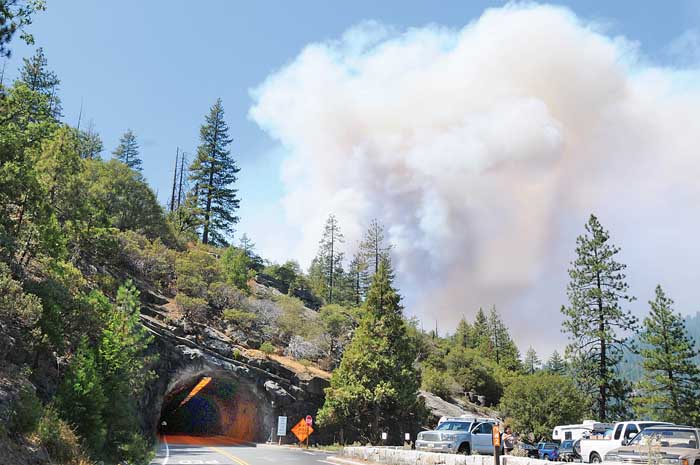Yosemite National Park’s escaped prescribed fire, the Big Meadow fire,
…got out of control when one cedar tree took off and cast embers into a lot of dry fuel,” spokesman Gary Wuchner said. “Then the winds changed direction, to the west, and the fire crossed Big Oak Flat and Foresta roads.”

The park says the fire has now burned 2,244 acres, up from the 2,200 reported yesterday.
From the Union Democrat:
On Thursday, turnouts along Wawona Road were jammed with tourists observing the fire’s rapid spread across the stumpy forest and the vibrant cloud of smoke hovering over it.
“It’s exciting but sad,” said Laurie Larson, of San Pedro. “You don’t want to see a controlled burn get out of control.”
Sharon Griffiths, visiting from Reading, Pa., was atop Half Dome watching the prescribed burn begin to get out of control on Wednesday.
“You could see the smoke beginning to really come off the fire,” she said.
Resources from across the state have shifted to the blaze as quickly as it has grown. As of Thursday, 500 firefighters, three helicopters, four air tankers and 24 fire engines were fighting the flames.
Included in the personnel is an interagency team headed by Stanislaus National Forest Division Chief Alan Johnson. Forest Service Hotshot crews from all over the state are fighting the blaze.
On Thursday, air tankers were disappearing into the cloud of smoke to make fire-retardant drops on the fire. Simultaneously, helicopters, sucking water from the Merced River near El Portal, made water drops on the perimeter of the fire. Dozers cut fire lines along the fire’s southern edge.
The smoke seemed to be blowing away from Yosemite Valley, which was relatively clear considering the growing blaze bordering it. Late in the day, along El Portal Road just outside of the valley, the landscape had a golden hue from the blanketing smoke.
Wuchner said, unfortunately, hindsight is not a tool the fire crews can use to douse the flames.
“We are trying to take advantage of not having very many fires in the state,” he said of the large force congregating to extinguish the fire.
Mymotherload.com put together some time-lapse images of the fire:
(THE VIDEO IS NO LONGER AVAILABLE)


